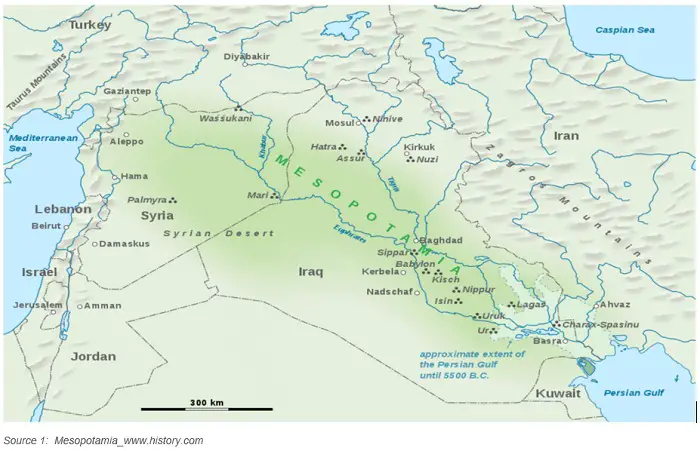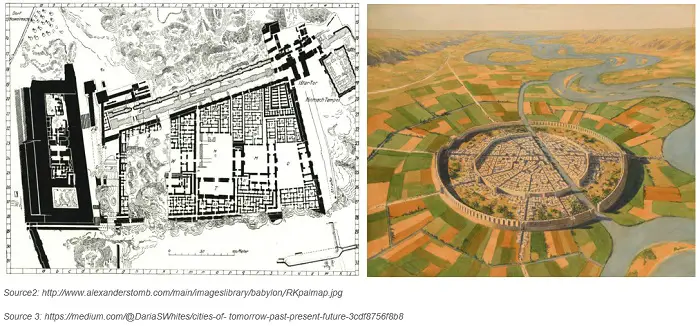Mesopotamia was a region in the Southwest Asia, on the fertile valley between the rivers Tigris and Euphrates. The word Mesopotamia originated from the two ancient words ‘Meso’ meaning ‘between’ and ‘Potamos’ meaning ‘river’. The region covered an area which spreads over modern-day Iraq, Kuwait, Turkey and Syria. The Mesopotamian cities were Washukanni, Ninevah, Hatra, Assur, Nuzi, Palmyra, Mari, Sippar, Babylon, Kish, Nippur, Isin, Lagash, Uruk, Charax-Spasinu and Ur. [1]

Settlements in Mesopotamia started from the Paleolithic era i.e., 14,000 BC, in which people started settling in circular houses and adopted agrarian culture. The civilization witnessed nearly 35 periods under seven ages. Sumerian was the dominant language along with Semitic and Subartuan. [1] [2] One of the most famous literature work from the period is the poem, Epic of Gilgamesh, which has two main versions namely Standard Babylonian version and the Old Babylonian version. [1] [3] The famous law followed by the Sumerians was the Code of Hammurabi created on 1780 BC, later summarized as “An eye for an eye, a tooth for a tooth”.
Related Article: How Urbanisation is Affecting India’s Cultural Heritage Sites
The City and It’s Composition
The oldest of the Mesopotamian cities were believed to follow an irregular and unplanned pattern of development. Protection from summer sun was one of the major consideration for the Mesopotamian cities. The cities were known for their crowded character. The residential areas displayed a method in which houses were built, pressed to each other side-side or back-back, especially in Ur, Nippur and Sippar. [4] The characteristics of Mesopotamian cities were discussed in detail by Van De Mieroop. According to his observation and findings, it can be summarized that the Sumerians preferred elevated situations and possessed wall with gates at regular intervals, streets and canals were used as separation for different areas of the city. [5] Major elements of the plan are street network, canals, city walls, gates, palaces, temples, ziggurats and open spaces. Given below is the plan of Babylon and Uruk.

The City Walls
The cities of Mesopotamia were surrounded by huge fortified walls. They represented conflict and violence and also implied the threat of warfare. They have specific dimension and thick structure, for example, Uruk had city walls 7m tall with gates and towers. The area inside the walls was densely yet non – uniformly built. [5] [6]
Street Network & Open Spaces
The two important factors for Mesopotamian streets plan are dimension of the street and motion of the sun. They preferred diagonal orientation which comprise the benefits of the two common patterns of the modern day: north – south orientation and east – west orientation. This orientation provided even distribution of sun and shade throughout the day. Majority of the streets had their corners oriented to a cardinal point and their sides were along the main orientation of the street. It has been recorded that there was a three tier hierarchy for streets and alleys, in Babylonia – the broad street as thoroughfare for gods; the narrow street as thoroughfare for people and the dead –end alleys as exits. Recent studies show that Babylonia and Borsippa used rectangular grid pattern for road network, during the Neo – Babylonian period. Some streets were named associating them with specific city gates like ‘street of the Urash Gate’. Borsippa was a square outlined city crossed by the streets with the temple at the center. Mesopotamians also followed the concept of Shadow network – the streets and valleys to have the major areas and features of the city to be linked by continuous shade that prevents the disturbance by sun. [4] [5] [6]
There are no excavation reports about unbuilt land in Mesopotamian cities, but historical records mention the existence of Royal Gardens and Orchards especially in Babylon.
Canals & Drains
The Mesopotamian irrigation system was the basin type canal, in which the opening is created by digging a gap in the embankment and then closed by placing mud back into the gap. A similar system was followed by the Egyptian civilization. In most cities that were not situated on the rivers like Uruk, canals were observed to be running along the road network. Babylon was bisected by Euphrates and canals were built through them. [5] [7]
The drainage system for the houses were individual responsibilities. Mesopotamians adopted soakaways for the purpose, a method in which shafts were dug into the floor and then lined with hollow ceramic drums vertically laid one above the other. Another type of drains were the baked brick ones running through the base of the walls that drains onto the streets. Rainwater drains were often equipped with vertical drains leading to an external pipe and then into a sump on the adjacent street. [5]
Housing Structures
Houses had flat roofs which were accessible through staircase or ladder. The size of houses varied from 100sq.m to 600sq.m. Houses built during the Ubaid Era adopted T shaped plan with additional rooms along the two longer sides. The earlier houses had buildings that were side attached. [4] [6]
Places, Temples & Ziggurats
Palaces of Mesopotamia emerged since the third millennia. They were extensive with provisions for ceremonial and administrative functions.
Each city has a temple called ‘Ziggurats’, where they worshipped the principal deity and in some, other gods or goddesses, usually situated at the heart of the city. They had multiple series of giant steps that elevated them from ground. It had a pyramidal shape with a flat top, on which the shrine was built. The stairs that led to the top was only meant for the priest and chambers were built inside for religious needs. [6] [8]

Conclusion
Mesopotamia had a dense, non-uniform cities with diagonal orientation for streets. The canals run along the road network. The drains are oriented according to requirement. Houses evolved from circle shaped ones to flat roofed ones. The palaces were extensive and ziggurats were located at the heart of the cities. The street pattern are considered the most efficient till date.
Author Bio:
Kalyani Vinod
Member of NOSPlan
School of Planning and Architecture, Vijayawada
REFERENCES
- [1] history.com, “history.com,” A & E Television Networks, 17 november 2017. [Online]. Available: https://www.history.com/topics/ancient-middle-east/mesopotamia. [Accessed 12 June 2020].
- [2] A. L. Oppenheim, “Ancient Mesopotamia : portrait of the dead civilisation,” The University of Chicago Press, London, 1977.
- [3] A. R. George, “Shattered tablets and tangled threads: Editing Gilgamesh, then and now,” Aramazd. Armenian Journal of Near Eastern Studies, 28 June 2009.
- [4] M. Shepperson, “Planning for the sun: Urban form as a Mesopotamian response to the sun,” Taylor & Francis Ltd, 2009.
- [5] G. Leick, The Babylonian World, Canada: Routledge, 2007.
- [6] S. Pollock, Ancient Mesopotamia, Cambridge: Cambridge University Press, 1999.
- [7] L. W. May, “water encyclopedia,” [Online]. Available: http://www.waterencyclopedia.com/Hy-La/Irrigation-Systems-Ancient.html. [Accessed 14 June 2020].
- [8] “History on the net,” Salem Media, 25 March 2019. [Online]. Available: historyonthenet.com/ziggurats-and-temples-in-ancient-mesopotamia. [Accessed 14 June 2020].